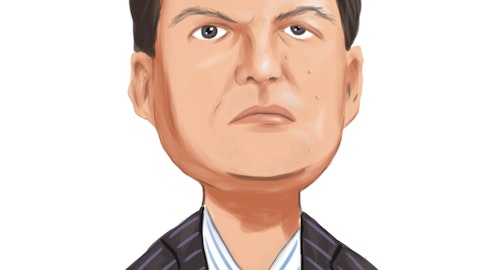Signet Jewelers Limited (NYSE:SIG) Q2 2024 Earnings Call Transcript August 31, 2023
Signet Jewelers Limited beats earnings expectations. Reported EPS is $1.55, expectations were $1.34.
Operator: Good morning, ladies and gentlemen, and welcome to the Signet Jewelers Q2 Earnings Conference Call. At this time all lines are in a listen-only mode. Following the presentation, we will conduct a question-and-answer session. [Operator Instructions] This call is being recorded on Thursday, August 31, 2023. I would now like to turn the conference over to Rob Ballew, SVP of Investor Relations. Please go ahead, sir.
Rob Ballew: Good morning. Welcome to Signet Jewelers second quarter earnings call. On the call today are Signet’s CEO, Gina Drosos, and Chief Financial, Strategy and Services Officer, Joan Hilson. During today’s presentation, we will make certain forward-looking statements. Any statements that are not historical facts are subject to a number of risks and uncertainties. Actual results may differ materially. We urge you to read the risk factors, cautionary language and other disclosures in our annual report on Form 10-K, quarterly reports on Form 10-Q and current reports on Form 8-K. Except as required by law, we undertake no obligation to revise or publicly update forward-looking statements in light of new information or future events.
During the call, we will discuss certain non-GAAP financial measures. For further discussion of the non-GAAP financial measures as well as a reconciliation of the non-GAAP financial measures most directly comparable to those GAAP measures, investors should review the news release we posted on our website at www.signetjewelers.com/investors. With that, I’ll turn the call over to Gina.
Gina Drosos: Thank you, Rob, and thanks to all of you for joining us today. Before getting into our prepared remarks, I want to thank our Signet team for their dedication, resilience and disciplined execution this quarter. In a challenging environment, we over-delivered on our commitments. Signet’s recognition as a great place to work is driven entirely by our team members’ capability and commitment and the winning and inclusive culture we continue to build together. There are three key messages I’d like to emphasize today. First, we are on track to deliver the year. In the second quarter, we exceeded our revenue and bottom-line commitments, and we remain confident in our full year guidance. We delivered these results in a challenging macro environment, which impacts our mid-market customers disproportionately, and as we predicted, with significantly fewer engagements in the quarter resulting from COVID’s disruption of dating three years ago.
Our performance against these headwinds reflects both the agility of our team and our flexible operating model. Second, trends are modestly improving. We’ve seen generally modest improvement in customer traffic and purchase behavior since early June, with lower price points rebounding, particularly in fashion. Average transaction value or ATV appears to have stabilized and is trending roughly in line with last year. Further, our data capabilities now allow us to track 45 signals of couples progressing toward engagement, and these are falling in line as we anticipated, pointing to a multiyear recovery beginning in our fourth quarter. These are all positive signs as we finalize our preparations for the holiday season. Third, we are widening our moat of competitive advantages, especially in our personalized marketing, digital experience, data analytics and services.
We are generating meaningful cost savings, on track to land between $225 million to $250 million this year and reinvesting to drive market share growth over time. We remain confident that we can deliver the midterm goals we outlined at our Investor Day earlier this year. Let’s take a closer look at each of these three messages, beginning with our performance in the second quarter. We exceeded the high end of our guidance in Q2, delivering approximately $1.6 billion in sales and $103 million in non-GAAP operating income. We achieved this quarter’s results despite the meaningful drags of both the challenging macro environment and the predicted decline in engagements. We believe we continue to grow bridal share during this trough and we are confident that engagements are on track to begin their multiyear recovery later this year.
Non-GAAP operating income reflects core merchandise margin expansion of more than 180 basis points compared to last year, driven by an increase in services mix, our scaled sourcing efforts and higher lab-created diamond mix, which remains a mid-teen percentage of our diamond business mix. Because of Signet’s strategic efforts in branding, style offerings and specialty cuts, the items we are selling with LCDs carry both a higher margin and higher ATV than natural diamonds. Importantly, compared to this time pre-pandemic, non-GAAP operating margin is up 250 basis points on 18% higher sales despite 16% fewer stores, showcasing that our transformation and flexible operating model is working as intended. The second point I want to emphasize is the modest improvement we’re seeing in the overall health of our customer.
Fashion merchandise sales increased sequentially in the second quarter, up 4 points year-over-year compared to the first quarter results. This was led by stronger performances at Kay and Banter which saw improved same-store sales for much of the second half of the quarter. While overall fashion sales improved modestly, we saw a robust improvement through the quarter for fashion merchandise below $1,000. For example, Kay drove great performance in our refreshed basics assortment, comprised of timeless core product like [soups] (ph) and diamonds and gold as well as classic styles in neck and bracelet pieces. We’ve seen the same trend at accessible price points in Banter, pieces that provide customers with versatility and that they can wear every day.
Kay, Zales and Jared also saw comparable sales growth at the highest price points in our fashion assortment as our core banners remained strong in romantic gifting. Our data on independent jewelers shows declines in this segment, reflecting our share gains in the quarter. As we finalize our preparations for the upcoming holiday season, merchandising assortment plays a critical role in our strategy. For example, at Kay, we’re leaning into innovation in yellow gold, which continues to trend well and is also multiculturally appealing. Kay is also focusing on gift box assortments under $500 as well as strong bridal innovation, including larger center stone pieces and new collections in Neil Lane and Monique Lhuillier. At Zales, we’ll bring new styles into our premier bridal collection Vera Wang Love, while also introducing new fine jewelry essentials, including hoop earrings in multiple metal options and sizes as well as diamond fashion at accessible price points for everyday wear and gifting.
At Jared, we have lifted the penetration of yellow gold to 30% across bridal innovated around the collection of gender-inclusive bands and engagement rings and developed a beautiful new elevated entry price personalized charm collection with New York City influencer design Lisa Salzer with a collection from Lulu Frost. We believe this innovation is on trend culturally and at the right price points. Similar to last year, we anticipate that customers will wait a bit later into the holiday season to begin their shopping. Economic pressure on discretionary dollars often leads customers to delay their shopping to Black Friday and the days leading into Christmas. We’ve built our marketing, labor planning and merchandising strategy for the back half to attract these customers with this in mind.
In marketing, this means leveraging our customer data to drive smarter, more personalized messaging on the platforms that our customers are using most, making more effective and efficient use of our spend. Within our labor planning, we’re using store-by-store hour-by-hour level data to match labor hours to customer demand. The key message here is that our data and scaled innovation positions us with meaningful advantages for the holidays. The third and most important point I want to make is our continued confidence that we can deliver our midterm goals over the next three to five years as we continue to invest to widen our competitive advantages. Two of the most common questions we received from investors are, first, how we’ve bridged our current year performance from pre-pandemic, and second, how we’re bridging the current year to our midterm goals.
We’ve posted a new investor deck this morning, which I believe addresses these two questions, and I’ll devote the balance of my remarks to why we are confident in our midterm goals. We’re focused on four growth drivers. Winning the engagement recovery, expanding accessible luxury, growing services and developing unassailable competitive advantages in digital and data-driven marketing. Taken together, we believe these four drivers will lead to a $9 billion to $10 billion in revenue, 11% to 12% annual non-GAAP EBIT margin and diluted non-GAAP EPS of $14 to $16 per share over the next three to five years. Importantly, both the current year and our midterm goals assume no pandemic spending lift, with a 1% to 2% compound annual growth rate for the jewelry category from calendar 2019 to calendar 2028.
The first big opportunity is bridal. By design, bridal is a big business for us, and as engagements begin their recovery later this year, we’re positioning ourselves to capture a multiyear tailwind. This is important because bridal is a highly strategic category. It’s frequently the most important emotional and financial point of market entry into the jewelry category. That means that in addition to initial sales, it drives the beginning of lifetime relationships leading to future purchases for special events, anniversaries and holidays throughout our customers’ lives. We see bridal as a $600 million revenue growth opportunity. Prior to the pandemic, we estimate the number of engagements was consistently close to 2.8 million per year. That began dropping last year, and we estimate it will bottom out this calendar year 2023 between 2.1 million and 2.2 million, or nearly 25% fewer engagements than normal.
Based on our data, we believe engagements will begin recovering in Q4 and fully rebound over the next three years. Just holding our estimated 30% share of the bridal market and engagement ATV constant, the 650,000 increase in total engagements is worth more than $500 million in revenue from engagement rings alone. But we are positioning ourselves to grow bridal market share as we are doing in 2023 and create competitive advantage in the bridal ecosystem of jewelry gifting as well as extending our reach into customers’ lifetime value. The remaining $100 million or more of opportunity reflects our investments in personalization, customization and the loyalty to accomplish this. So why are we confident that engagements will recover? Our confidence is based on 45 proprietary milestones we track to measure a couple’s journey toward engagement.
While every couple is unique, dating and relationships tend to follow patterns. Not every couple experiences all of the 45 milestones we track, but we know that once they reach 25 to 30 of these milestones, they become statistically significantly more likely to move on to engagement. This quarter, we saw the pool of couples approaching the 25 to 30 milestones increase by 700 basis points. Additionally, we are seeing states like Texas and Florida, which we opened earlier in the pandemic, 10 points closer to pre-pandemic engagement levels compared to California and New York, which reopened later in the pandemic. One final data point here. When we look at early relationship triggers, we’re also seeing improvement to last year. For example, one of the early relationship triggers we’ve mentioned before is going to a sporting event or a concert together, an indicator that is up 7% to early 2022.
This is equally important because this recovery will be multiyear and gradual. Signet is well positioned to win in this environment. We’ve identified a proprietary audience of more than 14 million people who are in dating relationships and are targeting them with education and marketing that’s right for them as their journey progresses. Our next growth driver is accessible luxury, which we believe represents $1 billion in revenue growth potential driven by tiering up the Jared brand, expanding the Diamonds Direct fleet and growing our digital banners, James Allen and Blue Nile. We believe Jared represents a $500 million growth opportunity as we expand the assortment of more premium offerings. Compared to Q2 of fiscal year ’20, this strategy has already led to growth of ATV of more than 60% at Jared.
Importantly, this reflects only a low single-digit impact from taking price as Jared’s ATV improvement has been driven almost completely by assortment optimization and premium items. Our test pilot for preferred assortment continues to drive significantly higher comparable revenue than the remainder of the fleet. And based on early results, that alone would be worth more than $100 million in revenue applied to all Jared stores. We will be expanding the preferred assortment to 50 additional stores in the third quarter ahead of the upcoming holiday season with further expansion planned in coming quarters. We expect to grow Diamonds Direct revenue by $350 million over the medium term as we open more than 20 new locations across the country, each of which we expect will build to over $15 million of average annual revenue.
Notably, Diamonds Direct revenue is highly skewed to bridal with an ATV that is more than four times the average of our other banners. Rounding out growth in accessible luxury are our digital banners, often the tip of the spear for digital enhancements and innovations, our midterm goals reflect a path to more than $1 billion in revenue between Blue Nile and James Allen. We are pleased that the digital re-platform was completed on time at the end of July, and we are now fully focused on delivering the growth and synergies made possible by this acquisition. Our third growth driver is services, which we see growing by $500 million to $1.2 billion in revenue. Services, which have a roughly 20-point margin premium over merchandise, will see about half of that growth from extended service agreements, or ESAs, as we focus on customer visibility and employee training to enhance our customer shopping experience by providing a path to worry-free wear, building trust and growing our lifetime customer base.
We drove a 370 basis point increase to ESA attachment rate on in-store bridal purchases this quarter compared to prior year. Product education for our jewelry consultants or JCs, as well as pricing transparency for our customers has been key. We continue to introduce product enhancements like post-purchase attachment. This feature allows customers to purchase the ESA up to 30 days after the jewelry purchase, allowing our JCs to follow up, for example, with the purchaser after the gifting occasion. The progress we’ve made in ESA is one of the reasons Services outperformed merchandise again this quarter as we delivered more than 4% growth in Services revenue. Customization, repair and piercing will drive the rest of the growth in Services. Last month, we acquired SJR National Repair, primarily a full-service jewelry and watch repair services business.
This acquisition complements the recent transition of Signet’s Blue Nile Seattle fulfillment center to a new enterprise-wide repair facility. Signet’s national service network now enables business-to-business repair services, watch repair and mailing capabilities among other offerings. We are also increasing the number of locations that provide piercings as well as soldering for permanent jewelry, which is a growing trend, particularly among Gen Z and social media platform users. The final growth driver is our increasingly digital and data-driven approach to marketing, which enables highly personalized communication and experiences. We see a [$450] (ph) million opportunity here. We’re continuing to grow our newly implemented customer data platform or CDP.
This platform is helping us drive both more effective marketing and customized digital shopping experiences. We increased our return on advertising spend by more than 20% this quarter when compared to this time last year by enhancing our targeting and optimizing our channel mix. Further, when a known customer visits our website, we personalize their experience with content based on the customers’ known interests, intent and prior shopping behavior. This more personalized shopping experience often targets relevant life, for example, dating, anniversaries, graduations or potential engagements. We recently launched personalized product recommendations for our customers as our first activation and have plans for many others. This level of personalization at scale is a clear competitive advantage.
Rounding out my comments on personalization and customer data, I’d quickly point out that we continue to make great progress in participation and impact with our loyalty program. This quarter, we increased our total enrollment by more than 30%. The ATV of our loyalty members this quarter was 40% higher than non-loyalty members. We continue to test loyalty offerings that elevate the shopping experience in ways unique to jewelry and special occasions. What I hope you can see is that we have concrete achievable building blocks that get us to our midterm goals, and these strategic initiatives are in flight and showing the results we expect. Signet’s business fundamentals are strong and the structural changes we’ve made over the past few years are working as we intended.
As a result, we believe our confidence in our midterm goals is well placed. I’ll now pass it over to Joan.
Joan Hilson: Thanks, Gina, and good morning, everyone. Our performance this quarter reflects the strength and importance of our flexible operating model as we delivered on our commitments amidst a challenging retail landscape. We drove over $1.6 billion in sales this quarter, down 8.1% to this time last year, with same-store sales down 12%. We have seen top-line improvements since the May time frame with second quarter comp sales better than the first quarter, driven by a stronger June and July. Bridal performed as we expected, and we saw an increase in conversion in the second quarter compared to the first quarter. We saw sequential improvement in price points below $1,000, particularly within the fashion assortment. Our average transaction value in North America grew more than 4%, with 5 points attributable from Blue Nile.
Comparable ATV was relatively flat, consistent with the last quarter. Compared to pre-pandemic, our core banners have grown low single digits driven by off-mall and e-commerce growth. Services represents nearly half of the growth in our core banners over the last four years with fashion driving the balance, consistent with our strategic priorities. Consumer access to credit in the quarter was healthy and approval rates remain near historical norms with overall payment plant penetration at 44%, and the amount financed are both relatively consistent to last year. While we’re not directly impacted by rising or declining delinquency rates, those rates among our finance partners have been stable in recent months. Within our agreements, we have guaranteed commitment levels.
Turning now to gross margin. We delivered $611 million of gross margin or 38% of sales, roughly in line with last year. Overall merchandise margin expanded 80 basis points, largely due to higher services margin as well as a higher penetration of services. Additionally, while organized retail crime loss is up across retailers generally, our mitigation efforts have resulted in a decrease and store losses compared to the same time last year, boosting gross margins by 15 basis points. Offsetting those gains is deleveraging of fixed costs such as occupancy on lower sales. Now turning to SG&A. Our non-GAAP spend of $507 million or 31% of revenue was 420 basis points higher than last year. Our total SG&A dollars increased due to the Blue Nile acquisition.
As we said, we continue to make strategic investments to enhance our moat of competitive advantages which was approximately 120 basis points of the deleverage in SG&A during the quarter. The remaining balance is due to advertising shift into Q2 from Mother’s Day timing and deleveraging of fixed cost on lower volume. As a result, we drove a non-GAAP operating margin of $103 million this quarter or 6.4% of sales, above our guidance range on the improved performance in June and July. We remain on track to deliver cost savings in the range of $225 million to $250 million, which is reflected in our guidance, which is split fairly evenly between gross margin and SG&A. Key drivers of the savings include non-customer impact initiatives such as product sourcing initiatives through the loop, cloud integration, enhanced credit agreements and advertising efficiencies.
Tracking as we expected through the first half of the year, we achieved approximately $75 million of savings. As we mentioned last quarter, we plan to close up to 150 stores as part of our fleet optimization efforts over the next 12 months. Approximately 90% of these expected store closures are in mall locations and/or are among the lower performing stores in the UK market. We also expect to open between 30 to 35 new stores, primarily Kay, Jared and Diamond Direct locations, which have bigger stores and higher ATVs than the closures. This means that while our store count will decline by roughly 4%, our total square footage will be similar to the prior year. We ended the quarter with $2.1 billion in inventory, which was down $97 million to last year.
Inventory, excluding Blue Nile, was down $167 million or 8% and compared to last year and when compared to pre-pandemic, it was down 20%, excluding acquisitions. Our inventory turns at 1.4 times, consistent with the first quarter is 40% improved compared to pre-pandemic. We see opportunities to further improve our turns over time. The health of our inventory has improved significantly over the last four years, with clearance inventory reduced by approximately 50% compared to pre-pandemic, providing room for critical newness within our assortment. Now turning to the balance sheet. We ended the quarter with over $690 million of cash and equivalents, down $162 million compared to a year ago. Recall that we paid out $200 million in legal settlements in the first quarter as well as acquired Blue Nile last Q3 for nearly $390 million.
Excluding those onetime items, we would have increased our cash position by roughly $425 million compared to the prior year. Our forward capital allocation priorities continue to be led by strategic investments to drive organic growth, including $75 million in expenses this year focused on our digital and consumer insight capabilities and up to $200 million in capital investments. Our other three capital allocation priorities include capital returns to shareholders, maintaining a strong balance sheet and small capability building tuck-in acquisitions like SJR Repair. Capital returns to shareholders remain an important part of capital allocation. We repurchased $43.3 million of shares in the quarter or nearly 700,000 shares and have repurchased $82.4 million year-to-date.
We had approximately $718 million in remaining repurchase authorization at the end of the quarter. This morning, we also declared a $0.23 dividend to common shareholders which, as a reminder, is 15% higher than a year ago, and we believe being a dividend growth company is an integral part of our capital allocation strategy. Within our debt structure, $148 million in bonds are now current, and we anticipate paying those off at maturity next June with cash on hand. The convertible preferred shares, which dilutes our share count by approximately 15% are resumable in November 2024 and we are weighing our options to address those at this time and look forward to sharing those plans when we are able. Turning to guidance. Consistent with my comments last quarter, we continue to anticipate a cautious consumer driven by macro pressure reflected in traffic decreases.
We will continue to use strategic levels of promotion to encourage traffic and conversion. For the third quarter, we expect revenue in the range of $1.36 billion to $1.41 billion and non-GAAP operating income in the range of $10 million to $25 million. The top end of our range assumes comp trends similar to the first half. We continue to expect a deleverage of fixed costs to continue in the third quarter on lower sales. as well as the impact of strategic investments, which will be marginally higher as a percentage of sales in the third quarter due to seasonally slower revenue. We expect to achieve approximately $65 million of cost savings in the third quarter. Of note, Blue Nile becomes comparable beginning in the third quarter. For the full year, we are reaffirming revenue and non-GAAP operating income guidance.
Recall that fiscal ’24 revenue guidance is in the range of $7.1 billion to $7.3 billion, and non-GAAP operating income in the range of $635 million to $675 million. We are raising our non-GAAP earnings per share guidance to be in the range of $9.55 to $10.14, reflecting share repurchases in the second quarter. Recall in the fourth quarter, we believe we will begin a multiyear engagement recovery. We will cycle shutdowns in the UK in the fourth quarter, and our strategic investment impact is lower as a percent of sales due to the seasonally strong holiday revenue. Before we move on to Q&A, I want to thank our team for their focus on the consumer, which enabled us to exceed our revenue and bottom-line commitments in the quarter and advance our strategic priorities.
With that, we’ll open the line for Q&A.
See also 10 Stocks That Are About To Explode and 16 Best High Volume Stocks To Buy Today.
Q&A Session
Follow Signet Jewelers Ltd (NYSE:SIG)
Follow Signet Jewelers Ltd (NYSE:SIG)
Operator: Thank you, Ma’am. Ladies and gentlemen, we will now begin the question-and-answer session. [Operator Instructions] Your first question comes from the line of Ike Boruchow from Wells Fargo. Please go ahead.
Ike Boruchow: Hey. Okay. Good morning, everyone. I guess two questions from me. Maybe, Joan, just a little bit more, just back to credit, given what’s in the headlines of late. Can you just make sure we all understand, like, is there a profit share that’s embedded in your credit arrangements today? I know your credit business is very different than what it was five years ago. So, I guess my first question there is, is there a profit share — and then how do you — yes or no, how do you think about potential headwinds on your top-line in a tightening credit environment? And then I have a follow-up after that.
Joan Hilson: Great. Ike, thanks for the question. As you know, we — our consumers have access to a broad range of credit through strong partnerships that provide a variety of financing options and it’s on a cascading level. We’ve continued to achieve a financing penetration that’s roughly flat year-to-date to last year. It’s 44% just to dimension it. And 39% of that is with our private label credit card program. We have guaranteed commitment levels with our financing partners in terms of credit approval. And as you know, we have no consumer credit balance sheet risk, and we have no revenue or loss sharing provisions within our agreement. So while we don’t share in — the credit risk with our credit partners, our partners have indicated that our portfolio delinquency rates are in line with last year. And we also have strong partnerships, including second looks for lower credit scores.
Ike Boruchow: Got it. And then just one more follow-up. Just on margin, so can you just kind of — looking at the back half and specifically to 4Q, can you kind of talk about the bridge of the margin that you’ve seen in the first half and the improvement or the stabilization you’re kind of planning in the back half? Thanks.
Joan Hilson: Sure, Ike, thanks for the question. In the first half of the year, we saw a point of impact from Blue Nile, roughly 1 point from strategic investments that of roughly [$75 million] (ph) that we anticipate for the year and 2 points essentially from the deleverage on fixed costs given the lower comp range of double digit. In the third quarter, the strategic investments will be slightly higher impact because of the seasonally lower sales. But for the overall back half, the Blue Nile impact will begin to abate, we’ll have less deleverage on fixed costs with improved comp sales in from engagement recovery in UK cycling of the shutdowns and then more cost synergies, particularly in 4Q. This will allow operating margins to improve in the back half of the year.
Ike Boruchow: Great. Thanks.
Operator: Thank you. Your next question comes from the line of Lorraine Hutchinson from Bank of America. Please go ahead.
Lorraine Hutchinson: Thank you. Good morning. Can you talk to the factors driving the improved fourth quarter sales? And maybe just give us some more clarity on how much benefit you’ve included from the expected recovery engagements, the lapping of the issues in the UK and any other considerations?
Gina Drosos: Sure. Hi, Lorraine. Let me start on that and then, Joan, feel free to jump in. We — let me go through a little bit what’s included in our guidance and what’s not included in our guidance. So what is included is an assumption that the overall consumer environment stays the same or even worsens modestly. The cost savings that Joan talked about in her remarks of $225 million to $250 million, which is largely back-ended engagement decline. So we are expecting the — that engagements will begin to improve. The trough in Q3 and will begin to come up in Q4, but it is a multiyear recovery. So we have assumptions and that engagements will still be below a year ago in the fourth quarter. And we are assuming that the UK cycles, the shutdowns that were in fourth quarter last year.




